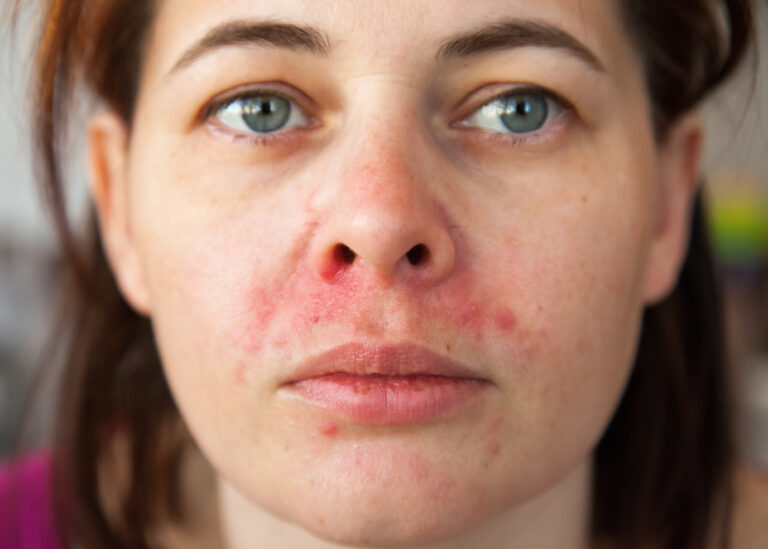Perioral dermatitis

What helps with perioral dermatitis?
People affected by perioral dermatitis usually get a big fright at first. No wonder, because the symptoms are very noticeable. Either scaly, light pink-coloured patches or inflammatory pustules form around the mouth. Sometimes the symptoms spread even further and affect the chin, forehead, cheeks and eyelids. This is often accompanied by very unpleasant itching. And because the skin barrier is disturbed, the skin dries out considerably, which leads to a feeling of tightness and an annoying burning sensation. As a result, perioral dermatitis is extremely painful. Many sufferers withdraw from public and social life as they are ashamed of the pustules, redness and scales. Others try to hide the clearly visible signs under a particularly thick layer of make-up, but this is counterproductive and makes the symptoms even worse. But what actually helps with perioral dermatitis and what kind of condition is it anyway?
Triggers and causes of perioral dermatitis
To put it simply, those affected are caught in a vicious circle. It starts with the complexion generally feeling dry. Then they turn to skincare products: many different and usually very rich skincare products. The skin reacts to this ‘overdose’ of skincare with perioral dermatitis, as the skin’s usually very high moisture content causes the horny layer to swell. This in turn damages the skin barrier and inflammatory processes have an easy time of it. Those affected react to this by using other different skincare products, creating the vicious circle mentioned at the beginning. Although regular skin care is important and good, it should never be overdone for this reason alone.
What you should know about perioral dermatitis
There is no risk of infection with perioral dermatitis. However, the symptoms are often very persistent and sometimes even last for months. The disease is also known as oral erysipelas or stewardess disease. The reason for the latter name is that stewardesses often wear a lot of make-up due to their job and therefore tend to put too much strain on their skin. If the inflamed areas spread around the eye area, doctors refer to it as peri-ocular dermatitis; if the nose is affected, it is called peri-nasal dermatitis.
The right skin care for perioral dermatitis
The first immediate measure sounds harsh, but it is immensely important: make-up and previous skin care products must be consistently avoided for the next few weeks. After all, they were the cause of the skin problems. Direct sunlight should also be avoided with perioral dermatitis. Instead, the skin with perioral dermatitis needs light fluid care, whereby the number of active ingredients should be minimised. When we consider that some products contain up to 30 different substances, it is no wonder that our skin literally reacts irritably to this oversupply. Squalane as a non-polar lipid and other low-irritant raw materials are best suited for treating perioral dermatitis.
These active ingredients also help with perioral dermatitis
Retinol (vitamin A) is a proven remedy for perioral dermatitis. It stimulates collagen synthesis in the epithelial tissue and cell growth. However, retinol should only be used in low concentrations or as a derivative in perioral dermatitis.
Niacinamide (vitamin B3) is also frequently used for perioral dermatitis. Dermatologists and doctors know that vitamin B3 has an anti-inflammatory effect that is very similar to that of clindamycin, an antibiotic. Good results can also be achieved with healing clay for perioral dermatitis. It is obtained from loess, which in turn consists of quartz, lime, clay silicates and various minerals and trace elements. Healing clay has an anti-inflammatory, soothing and cleansing effect. It is often used to treat eczema, acne and rashes.
Retinol profile
INCI: Retinol
CAS number: 68-26-8
EINECS/EILINCS-No.: 200-683-7
Alternative name: Vitamin A
Natural sources: Butter, egg yolk, fish, liver
Effect: promotes cell growth and collagen synthesis
Niacinamide profile
INCI: Niacinamide
CAS number: 59-67-6
Alternative names: Vitamin B3, nicotinic acid, pyridine-3-carboxylic acid
Texture: colourless crystals
Effect: strengthens the skin barrier, acts against inflammation, stimulates collagen production
Healing clay profile
INCI: Loess
Description: a light yellow to grey mineral sediment
Effect: anti-inflammatory, soothing, pain-relieving, cleansing
Aloe vera (direct juice)
INCI: Aloe Barbadensis Leaf Juice
CAS number: 85507-69-3 / 94349-62-9
EINECS/ELINCS number: 287-390-8 / 305-181-2
Description: Juice from the leaves of Aloe Barbadensis
Effect: moisturising, soothing, regenerating, anti-inflammatory, refreshing
Don’t panic with perioral dermatitis
Even if the pustules, scales and redness don’t look very nice and can really damage your self-esteem, the condition is not a dangerous or even contagious permanent condition, but usually ‘only’ the result of over-care or too much make-up. The skin is perfectly capable of recovering from this so that the symptoms disappear permanently. The most important thing now is to use gentle, mild and non-irritating skincare, which should consist of a few specific active ingredients. Cosmacon will be happy to develop appropriate formulations for you!